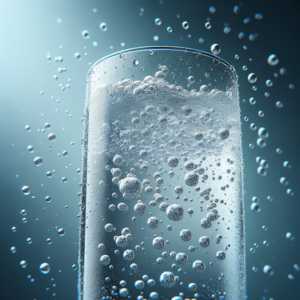So you’ve probably enjoyed a refreshing Sprite on a hot summer day or as a fizzy accompaniment to your favorite meal. But have you ever wondered if your beloved lemon-lime soda contains any caffeine? Well, in this article, we’ll uncover the truth about whether does Sprite have caffeine or not. We’ll also explore whether consuming Sprite on a regular basis is bad for your health. Get ready for some surprising facts and insights about this popular carbonated beverage!
What is Sprite and how much caffeine does sprite have?
Sprite is a popular carbonated soft drink that is known for its crisp and refreshing lemon-lime flavor. It is a non-caffeinated beverage that is enjoyed by people of all ages. In addition to its delicious taste, Sprite has become a household name due to its distinct branding and extensive marketing campaigns.
Sprite Ingredients
The composition of Sprite includes carbonated water, high fructose corn syrup, citric acid, natural flavors, and sodium citrate. These ingredients are carefully combined to create the unique flavor profile that sets Sprite apart from other soft drinks. The beverage is known for its clear, transparent appearance, which further adds to its appeal.
History of Sprite
Sprite was introduced by The Coca-Cola Company in the United States in 1961. Its creation was aimed at competing with other lemon-lime flavored sodas in the market. Originally, Sprite was called “Fanta Klare Zitrone” in Germany and “Clear Lemon Fanta” in other countries. However, in 1961, the name was changed to Sprite, which reflected the brand’s goal of bringing a fresh and lively beverage to the market.
Over the years, Sprite has undergone various brand revamps and updates to stay relevant and appealing to consumers. The brand is known for its catchy slogans and memorable advertisements, which have contributed to its widespread recognition and popularity around the world.
Popularity of Sprite
Sprite has gained significant popularity since its introduction. The refreshing taste and lack of caffeine make it a preferred choice for those seeking a non-caffeinated beverage option. It is often enjoyed on its own or used as a mixer in cocktails. Sprite’s popularity is evident from its presence in numerous countries and its consistent sales figures, making it one of the leading carbonated soft drinks globally.
Understanding Caffeine
What is Caffeine?
Caffeine is a natural stimulant that is commonly found in beverages such as coffee, tea, and energy drinks. It belongs to a group of compounds known as methylxanthines, which have a stimulating effect on the central nervous system. Caffeine is known for its ability to temporarily ward off drowsiness and improve alertness.
Effects of Caffeine on the Body
When consumed, caffeine enters the bloodstream and travels to the brain, where it blocks the action of a neurotransmitter called adenosine. Adenosine is responsible for promoting sleep and relaxation in the body. By inhibiting adenosine, caffeine stimulates the release of other neurotransmitters like dopamine and norepinephrine, which promote wakefulness and increased mental focus.
Caffeine also has other physiological effects on the body. It can increase heart rate, blood pressure, and metabolic rate. Additionally, caffeine has diuretic properties, meaning it can increase urine production and potentially lead to dehydration if consumed in excessive amounts.
Recommended Daily Intake of Caffeine
The recommended daily intake of caffeine varies depending on factors such as age, sex, and individual sensitivity to caffeine. In general, moderate caffeine consumption is considered safe for most healthy adults. The FDA suggests that consuming up to 400 milligrams (mg) of caffeine per day is not associated with any adverse health effects. However, it is important to note that caffeine affects individuals differently, and some people may be more sensitive to its effects.
It is recommended to be mindful of the caffeine content in beverages and to make informed choices about consumption based on personal sensitivity and needs.

Caffeine Content in Soft Drinks
Caffeine in Popular Soft Drinks
While many soft drinks contain caffeine as an ingredient, not all do. The caffeine content varies significantly among different brands and flavors. Some popular caffeinated soft drinks include cola beverages like Coca-Cola and Pepsi, energy drinks like Red Bull, and even some flavored sodas like Dr. Pepper. These drinks often contain varying amounts of caffeine, which can range from as low as 20 mg per serving to as high as 80 mg or more.
On the other hand, there are numerous non-caffeinated soft drinks available, and Sprite is one of them. Sprite is specifically marketed as a caffeine-free option, catering to individuals who prefer to avoid or limit their caffeine intake.
Why are Soft Drinks Caffeinated?
One reason why some soft drinks are caffeinated is that caffeine is a naturally occurring compound found in ingredients like coffee beans, tea leaves, and cacao beans. In beverages that are derived from those sources, such as coffee and tea, the caffeine content is inherent.
In the case of soft drinks, caffeine is added to enhance the flavor and provide a stimulating effect. Caffeine can contribute a slightly bitter taste, which can balance the sweetness of other ingredients in the beverage. Additionally, the stimulant properties of caffeine can create a more energizing sensation, which some individuals enjoy.
Health Risks Associated with Excessive Caffeine Intake
While moderate caffeine consumption is generally considered safe for most healthy individuals, excessive caffeine intake can lead to several health risks. These risks include increased heart rate, high blood pressure, gastrointestinal issues, trouble sleeping, anxiety, and even addiction.
Individuals who are more sensitive to the effects of caffeine or have certain health conditions, such as cardiovascular problems or sleep disorders, may be particularly vulnerable to the adverse effects of excessive caffeine intake. It is essential to be mindful of personal tolerance and to consume caffeine in moderation to avoid these potential risks.
Does Sprite Have Caffeine?
Caffeine in Sprite
Sprite is proudly marketed as a caffeine-free soft drink. Unlike many other carbonated beverages, Sprite does not contain any added caffeine. This makes it a suitable option for individuals who want to avoid or reduce their caffeine consumption.
By offering a caffeine-free alternative, Sprite caters to a wide range of consumers, including those who are sensitive to caffeine, children, and individuals who prefer a non-stimulating beverage option. The absence of caffeine in Sprite allows individuals to enjoy the refreshing taste without the potential side effects associated with caffeine consumption.
Caffeine-Free Alternatives
For individuals who enjoy the taste of Sprite but want to avoid the sugar content, there are also caffeine-free, zero-calorie alternatives available. These alternatives often use artificial sweeteners to provide the same flavor experience without the added calories. Examples of such products include Sprite Zero and Sprite Zero Sugar. These options can be a suitable choice for those who are conscious of their sugar intake or are following a low-calorie diet.
Sprite’s Marketing Position
Is Sprite Caffeine Free?
Sprite’s positioning as a caffeine-free beverage is an essential aspect of its marketing strategy. The brand aims to appeal to health-conscious consumers who prefer soft drinks without the stimulating effects of caffeine. Additionally, Sprite’s marketing often emphasizes its refreshing and quenching qualities, promoting it as a suitable choice for hydration and enjoyment.
Sprite’s caffeine-free status also makes it a popular option for mixing with alcoholic beverages. By combining Sprite with spirits like vodka or rum, individuals can enjoy a refreshing and flavorful cocktail without the added caffeine boost.

Health Impact of Sprite
Sugar Content in Sprite
While Sprite may be caffeine-free, it does contain a significant amount of sugar. A regular 12-fluid ounce serving of Sprite contains approximately 38 grams of sugar, which is equivalent to around 9 teaspoons. Excessive sugar consumption has been linked to various health issues, including obesity, diabetes, and tooth decay.
It is important to be mindful of the sugar content in beverages like Sprite and incorporate them into a balanced diet. Moderation is key to minimize the potential negative health impacts associated with high sugar intake.
Artificial Sweeteners in Sprite
In response to the increasing demand for low-calorie alternatives, Sprite offers variations that utilize artificial sweeteners instead of sugar. These artificially sweetened options, such as Sprite Zero and Sprite Zero Sugar, contain zero calories and are free from the sugar found in regular Sprite.
Artificial sweeteners, including those used in Sprite Zero variants, have been approved for consumption by regulatory authorities such as the U.S. Food and Drug Administration (FDA). They provide a sweet taste without the added calories of sugar. However, like any other food or beverage ingredient, some individuals may have sensitivities or preferences regarding artificial sweeteners, so it is important to consider personal factors when choosing these alternatives.
Effects of Sprite on Health
The effects of Sprite on health can vary depending on factors such as overall dietary habits, individual metabolic rate, and consumption patterns. While enjoying a Sprite occasionally as part of a balanced diet is unlikely to have significant negative effects, regular and excessive consumption can contribute to weight gain, dental issues, and an increased risk of chronic diseases associated with high sugar intake.
It is important to be aware of personal consumption patterns and make informed choices regarding the inclusion of Sprite in one’s diet. Opting for Sprite caffeine-free versions or alternatives that are low in sugar can help mitigate potential health risks.
Comparing Sprite to Other Soft Drinks
Nutritional Comparison: Sprite vs. Cola Drinks
Sprite and cola drinks like Coca-Cola and Pepsi have distinct flavor profiles and nutritional compositions. While Sprite is known for its lemon-lime taste, colas have a darker and sweeter flavor profile. From a nutritional standpoint, colas generally contain higher amounts of calories and sugar compared to Sprite. The specific values may vary among brands and serving sizes, but on average, cola drinks have a higher sugar content.
It is important to note that excessive consumption of high-sugar beverages, regardless of the specific brand or flavor, can contribute to unhealthy weight gain and potential health issues. Moderation and balance are key when considering soft drinks as part of a healthy diet.
Health Considerations: Sprite vs. Other Soft Drinks
When considering the health impact of soft drinks, it is crucial to take into account individual factors and overall dietary habits. While Sprite is caffeine-free and can be enjoyed as a refreshing choice among carbonated beverages, it still contains a significant amount of sugar. Individuals who are concerned about their sugar intake may opt for beverages like diet soda or water instead.
Furthermore, it is essential to note that soft drinks should not replace adequate hydration through water intake. Drinking enough water throughout the day is crucial for maintaining proper bodily functions and overall well-being. Soft drinks, including Sprite, should be consumed in moderation and as part of a varied and balanced diet.
Caffeine Content Comparison: Sprite vs. Other Soda Brands
Sprite stands out among soft drinks due to its caffeine-free composition. While some popular soda brands like Coca-Cola and Pepsi contain caffeine, Sprite offers an alternative for individuals who wish to avoid or reduce their caffeine consumption.
Caffeine-sensitive individuals, young children, or those who prefer a non-stimulating beverage option can turn to Sprite as a suitable choice. The absence of caffeine in Sprite allows for enjoyment without the potential side effects associated with caffeine, such as increased heart rate, jitters, or trouble sleeping.

Is Sprite Bad for You?
Negative Effects of Sprite on Health
While Sprite itself may not be inherently “bad” for you, excessive consumption of any high-sugar beverage can have negative effects on health. The high sugar content in Sprite can contribute to weight gain, dental issues, and an increased risk of chronic diseases like type 2 diabetes and cardiovascular problems.
It is essential to be mindful of overall sugar intake from various sources and strike a balance in one’s diet. Moderation and moderation are key to maintaining a healthy lifestyle.
Responsible Consumption of Sprite
Responsible consumption of Sprite involves being aware of personal dietary needs and being mindful of sugar intake. Enjoying Sprite occasionally as a treat or part of a balanced diet is unlikely to have significant negative effects. It is crucial to incorporate Sprite, or any other soft drink, into an overall healthy and varied diet.
Individuals struggling with weight management, diabetes, or other health conditions may benefit from limiting their consumption of high-sugar beverages like Sprite. Considering caffeine-free alternatives or low-sugar variations can offer more suitable options for those individuals.
Alternatives to Sprite
For individuals seeking alternatives to Sprite, there are several options available. Caffeine-free lemon-lime sodas from other brands can provide a similar taste experience without the sugar content. Additionally, flavored sparkling water or homemade infused water can offer a refreshing and hydrating alternative to carbonated soft drinks.
Fruit-infused water, herbal teas, and natural fruit juices without added sugars are other choices to consider when looking for flavorful and non-caffeinated beverages.
Managing Caffeine Intake
Caffeine Sensitivity and Individual Differences
Individuals vary in their sensitivity to caffeine, with some people experiencing more pronounced effects than others. Factors such as body weight, metabolism, and genetic predisposition can influence how individuals respond to caffeine.
If you have a low tolerance to caffeine or have experienced negative effects from consuming caffeinated beverages, it is advisable to be cautious and monitor your caffeine intake. Opting for caffeine-free beverages like Sprite can be a suitable choice to avoid any potential adverse effects.
Tips for Reducing Caffeine Consumption
For those looking to reduce their overall caffeine consumption, there are several strategies to consider:
- Gradual Reduction: Gradually decrease the amount of caffeine consumed each day to allow the body to adjust slowly.
- Substitute with Caffeine-Free Alternatives: Replace caffeinated beverages with non-caffeinated options like Sprite.
- Opt for Decaffeinated Varieties: Choose decaffeinated versions of your favorite beverages, such as decaf coffee or tea.
- Read Labels: Pay attention to the caffeine content listed on beverage labels and choose options with lower caffeine levels.
- Hydrate with Water: Prioritize water as the primary source of hydration throughout the day, reducing reliance on caffeinated beverages.
Moderation is Key
Regardless of personal caffeine sensitivity or preferences, moderation is key when it comes to managing caffeine intake. Being mindful of the amount of caffeine consumed and making informed choices based on individual needs and tolerance can help maintain a balanced and healthy lifestyle.

Conclusion
In conclusion, Sprite is a caffeine-free soft drink that offers a refreshing and flavorful alternative to caffeinated beverages. Its composition, which lacks added caffeine and includes a combination of carbonated water, flavors, and sweeteners, appeals to a wide range of consumers.
While moderate consumption of Sprite is unlikely to have significant negative effects, it is important to be mindful of its sugar content. High sugar intake, whether from Sprite or other sugary beverages, can contribute to health issues such as weight gain, dental problems, and an increased risk of chronic diseases.
Making informed choices, considering personal dietary needs and preferences, and balancing soft drink consumption with an overall healthy diet are essential for maintaining well-being. Ultimately, individuals should prioritize hydration through water intake and choose beverages like Sprite in moderation as part of a varied and balanced lifestyle.
Continue Reading…
